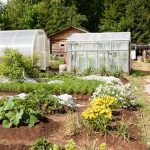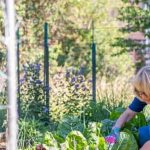Companion planting, the practice of pairing different plants to benefit each other, has been a longstanding tradition in vegetable gardening. From pest control to soil enrichment, certain plants can help improve the health and yield of a vegetable garden. This article explores the significance of companion planting and how specific plants play a crucial role in supporting the growth of vegetables.
The use of companion plants in vegetable gardens dates back centuries and has been recognized for its numerous advantages. By strategically selecting and placing certain plants together, gardeners can create a harmonious environment that promotes growth and overall plant health. Understanding the benefits of companion planting is essential for creating thriving vegetable gardens that are sustainable and productive.
In this article, we will delve into the various categories of plants that aid vegetable gardens, including beneficial insects, nitrogen-fixing plants, pest-repelling plants, and those that contribute to soil health. Additionally, we will provide insights on attracting pollinators to increase yields and explore the culinary uses of companion plants for enhancing flavors and culinary creativity. Understanding these aspects will empower gardeners to make informed decisions when selecting which plants to incorporate into their vegetable gardens for optimal results.
Beneficial Insects
In vegetable gardens, beneficial insects play a crucial role in maintaining a healthy and thriving ecosystem. These insects are not only essential for pollination, but they also act as natural pest controllers, helping to keep common garden pests at bay. By attracting beneficial insects to the garden, gardeners can reduce the need for chemical pesticides and promote a more sustainable approach to gardening.
Specific plants can be strategically chosen and planted to attract these beneficial insects. Some of the most effective plants include:
- Lavender
- Marigold
- Dill
- Fennel
- Sunflower
These plants release scents and nectar that attract ladybugs, lacewings, hoverflies, and other helpful insects that prey on aphids, mites, and other common garden pests. By incorporating these insect-attracting plants into the vegetable garden, gardeners can create a balanced and harmonious environment that supports both plant growth and insect populations.
In addition to providing a habitat for beneficial insects, these plants add aesthetic appeal to the garden while serving a practical purpose. Understanding the role of beneficial insects in the garden ecosystem is essential for successful vegetable gardening, and by planting specific flowers and herbs known for attracting these helpful creatures, gardeners can ensure a healthy and productive harvest.
Nitrogen-Fixing Plants
Nitrogen is an essential nutrient for plant growth, and having adequate levels of nitrogen in the soil is crucial for the successful cultivation of vegetables. Nitrogen-fixing plants play a significant role in enriching the soil with this vital nutrient, making them valuable companions in vegetable gardens.
Through a symbiotic relationship with certain bacteria, these plants are capable of converting atmospheric nitrogen into a form that can be utilized by other plants. This process not only benefits the nitrogen-fixing plants themselves but also contributes to the overall health and productivity of neighboring vegetables.
Nitrogen-fixing plants, such as legumes and clover, have the ability to take nitrogen from the air and convert it into a form that can be taken up by other nearby plants. When these plants are interplanted or rotated with vegetable crops, they essentially enhance the soil’s fertility by providing a natural source of nitrogen. This rich supply of nitrogen helps support vigorous vegetative growth, ultimately leading to better yields of vegetables like tomatoes, peppers, and leafy greens.
For successful companion planting using nitrogen-fixing plants, it is crucial to consider their compatibility with different vegetable varieties. Some common nitrogen-fixers like beans and peas can benefit a wide range of vegetables, while others may have specific associations with particular plant families.
For example, members of the legume family (Fabaceae) are known for their nitrogen-fixing abilities and often work well alongside crops such as corn, potatoes, and squash. Understanding these plant relationships can help gardeners optimize their vegetable garden layouts for improved soil fertility and crop production.
Incorporating nitrogen-fixing plants into a vegetable garden can be done through various methods such as intercropping or cover cropping. Intercropping allows for the simultaneous growth of different plant species within the same area, while cover cropping involves planting specific species during fallow periods to improve soil structure and fertility. By selecting suitable nitrogen-fixers based on their growth habits, seasonal preferences, and planting requirements, gardeners can create a more sustainable and balanced ecosystem that fosters healthy vegetable growth.
Pest-Repelling Plants
When it comes to maintaining a healthy and thriving vegetable garden, pest control is a crucial aspect that can significantly impact the overall yield. While there are various methods of pest management, using pest-repelling plants is an eco-friendly and natural approach that can help protect your vegetables from common garden pests. These plants release compounds or odors that act as natural deterrents, keeping harmful insects at bay without the need for chemical pesticides.
Certain plants have properties that make them effective in repelling pests from vegetable gardens. For example, marigolds are known for their ability to repel nematodes, which are microscopic soil-dwelling pests that can damage the roots of many vegetable crops. Similarly, aromatic herbs such as basil and mint emit strong scents that deter insects like aphids, ants, and beetles. Planting these pest-repelling options strategically throughout your vegetable garden can create a natural barrier against destructive pests.
Incorporating pest-repelling plants into your vegetable garden through companion planting can be a beneficial strategy for protecting your crops. By intermixing pest-repelling plants with your vegetables, you can create an environment that naturally discourages harmful insects while promoting the health and growth of your vegetables. Additionally, companion planting can also attract beneficial insects that prey on common garden pests, further enhancing the effectiveness of natural pest control in your garden.
In summary, integrating pest-repelling plants into your vegetable garden not only helps in ensuring a bountiful harvest but also contributes to creating a more balanced and sustainable ecosystem within the garden. By harnessing the natural properties of these companion plants, you can effectively manage pests while reducing reliance on chemical interventions.
Soil Health
When it comes to maintaining a thriving vegetable garden, the health of the soil is crucial. Certain plants can play a significant role in improving soil health and structure for better vegetable growth. For example, leguminous plants such as peas, beans, and clover are known for their ability to fix nitrogen in the soil.
These nitrogen-fixing plants work in harmony with vegetables by enriching the soil with essential nutrients that promote healthy growth. In addition to nitrogen fixation, other plants help in soil aeration, moisture retention, and nutrient absorption.
One plant that is particularly beneficial for soil health is the marigold. Marigolds are known for their ability to enhance soil structure through their root secretions which can help reduce nematode populations. Another beneficial plant is comfrey, which has deep roots that mine nutrients from the subsoil and make them available to other plants through decomposition when used as mulch or compost.
Adding these plants strategically within your vegetable garden can greatly improve the overall health of the soil and create an environment conducive to bountiful harvests.
| Beneficial Plants | Benefits |
|---|---|
| Leguminous Plants (Peas, Beans) | Nitrogen Fixation |
| Marigolds | Enhances Soil Structure, Reduces Nematodes |
| Comfrey | Mines Nutrients From Subsoil and Improves Soil Health |
Companion Planting Charts
Companion planting is a strategic method of gardening that involves growing different plants near each other to enhance the growth, flavor, and protection of specific vegetables. Companion planting charts serve as valuable tools for gardeners to plan their vegetable gardens effectively. These charts detail which plants are beneficial when grown together and which combinations should be avoided due to potential conflicts. Understanding the compatibility of different plants can help maximize garden space, minimize pests, and improve overall vegetable yields.
One popular example of companion planting involves growing tomatoes alongside basil. Basil not only enhances the flavor of tomatoes but also repels pests such as mosquitoes and flies. Similarly, planting carrots with onions can deter carrot flies while also providing shade and moisture retention benefits. By utilizing companion planting charts, gardeners can make informed decisions about which plants are best suited to grow alongside their beloved vegetables.
In addition to selecting favorable plant combinations, it’s essential to consider factors such as soil quality, sunlight exposure, and watering needs when planning a vegetable garden. Companion planting charts offer insight into these considerations as well, making them indispensable resources for both novice and experienced gardeners looking to create thriving and sustainable vegetable gardens.
| Compatible Plants | Avoid Planting With |
|---|---|
| Tomatoes + Basil | Tomatoes + Corn |
| Carrots + Onions | Beans + Onions |
| Cucumbers + Peas | Potatoes + Cucumbers |
Attracting Pollinators
One crucial aspect of maintaining a successful vegetable garden is ensuring proper pollination of the crops. Pollinators such as bees, butterflies, and hummingbirds play a vital role in this process, contributing to the development of fruits and vegetables. By incorporating specific plants that attract these pollinators, gardeners can significantly enhance the yield and quality of their produce.
To effectively attract pollinators to the vegetable garden, consider planting a diverse range of flowers and herbs known for their appeal to these beneficial insects. Some excellent options include:
- Lavender
- Sunflowers
- Borage
- Bee balm
- Echinacea
These plants are not only visually appealing but also serve as a source of nectar and pollen for pollinators. By strategically placing these flowers throughout the garden, you can create an inviting environment for bees, butterflies, and other valuable pollinating insects.
In addition to attracting the pollinators themselves, these flowering plants can also contribute to overall garden health by promoting biodiversity and ecosystem balance. This natural approach not only benefits the vegetable crops but also adds beauty and vibrancy to the garden space. By prioritizing plants that help vegetable gardens by attracting pollinators, gardeners can ensure improved harvests and sustainable gardening practices.
Culinary Uses of Companion Plants
In conclusion, companion planting is a valuable technique in enhancing the overall health and productivity of vegetable gardens. By strategically choosing specific plants that help vegetable gardens, gardeners can create a balanced ecosystem that promotes natural pest control, soil enrichment, and increased pollination. The practice of companion planting is not only beneficial for the well-being of the garden but also adds culinary value to the produce.
One of the significant benefits of incorporating companion plants in vegetable gardens is their culinary uses. For example, aromatic herbs such as basil and dill not only act as natural pest deterrents but also enhance the flavor of neighboring vegetables.
Additionally, edible flowers like nasturtiums and calendula serve as attractive garnishes while also attracting pollinators to increase vegetable yields. These dual-purpose companion plants not only contribute to a visually appealing garden but also add depth and complexity to home-cooked dishes.
Overall, understanding the relationship between different plants in a garden ecosystem can lead to a more harmonious and productive vegetable garden. By carefully selecting and incorporating plants that help vegetable gardens, gardeners can maximize the potential of their harvest while enjoying the added culinary benefits that come with diverse and purposeful plant combinations. With proper planning and implementation, companion planting can truly elevate the quality and taste of home-grown vegetables for a rewarding gardening experience.
Frequently Asked Questions
What Is the Best Plant for Vegetable Garden?
The best plant for a vegetable garden ultimately depends on the specific needs and preferences of the gardener. However, popular choices include tomatoes, peppers, lettuce, carrots, and various herbs like basil and parsley.
What Is a Good Companion Plant for Vegetables?
A good companion plant for vegetables can help with pest control or enhance growth. For example, marigolds can deter certain pests that may damage vegetables, while planting beans alongside corn can help enrich the soil.
What Flowers Do I Need to Plant in My Vegetable Garden?
Planting flowers in a vegetable garden can attract pollinators like bees and butterflies, which are essential for the successful growth of many fruits and vegetables. Some good flower options include sunflowers, zinnias, lavender, and cosmos.

If you’re looking to get into vegetable gardening, or are just looking for some tips on how to make your current garden better, then you’ve come to the right place! My name is Ethel and I have been gardening for years. In this blog, I’m going to share with you some of my best tips on how to create a successful vegetable garden.





